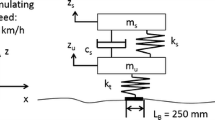Abstract
This paper describes a prototype device to estimate the trajectory of the piston in a free-piston driver. The device, which screws to the front face of the piston, has an internal data acquisition system which triggers upon piston launch and records the acceleration history across the complete piston stroke. A key feature is the incorporation of an optical waypoint detector. This comprises a laser which is directed onto the compression tube wall, and a photodiode which measures the reflected intensity. A series of evenly spaced high-contrast lines are marked on the tube surface, which appear as a pattern of intensity changes in the photodiode signal and define a set of exact position–time coordinates along the trajectory. Optical pattern recognition has previously been shown to be effective to identify piston traversal past a fixed detector; in this application, the order is reversed so that the detector is on the piston, and the pattern is at the fixed location. Waypoint detection permits computation of a precise in situ calibration of the accelerometer and correction of the acceleration integration along the piston stroke. The key benefits of this concept are that it provides a complete, fully time-resolved, accurate estimate of piston position, is self-contained and portable, and can be readily utilised on any free-piston driver without significant modification to the facility.
































Similar content being viewed by others
References
Stalker, R.J.: Isentropic compression of shock tube driver gas. ARS J. 30, 564 (1960)
Stalker, R.J.: A study of the free-piston shock tunnel. AIAA J. 5(12), 2160–2165 (1967). https://doi.org/10.2514/3.4402
Hornung, H.G.: The Piston Motion in a Free-piston Driver for Shock Tubes and Tunnels. GALCIT Report FM 88-1, Graduate Aeronautical Laboratories, California Institute of Technology (1988)
Itoh, K., Ueda, S., Komuro, T., Sato, K., Takahashi, M., Myajima, H., Tanno, H., Muramoto, H.: Improvement of a free piston driver for a high-enthalpy shock tunnel. Shock Waves 8, 215–233 (1998). https://doi.org/10.1007/s001930050115
Gildfind, D.E., James, C.M., Morgan, R.G.: Free-piston driver performance characterisation using experimental shock speeds through helium. Shock Waves 25(2), 169–176 (2015). https://doi.org/10.1007/s00193-015-0553-8
Gildfind, D.E., Morgan, R.G., McGilvray, M., Jacobs, P.A., Stalker, R.J., Eichmann, T.N.: Free-piston driver optimisation for simulation of high Mach number scramjet flow conditions. Shock Waves 21(6), 559–572 (2011). https://doi.org/10.1007/s00193-011-0336-9
Gildfind, D.E.: Development of High Total Pressure Scramjet Flow Conditions Using the X2 Expansion Tube. PhD thesis, Division of Mechanical Engineering, School of Engineering, The University of Queensland (2012)
Gildfind, D.E., Jacobs, P.A., Morgan, R.G., Chan, W.Y.C., Gollan, R.J.: Scramjet test flow reconstruction for a large-scale expansion tube, Part 1: quasi-one-dimensional modelling. Shock Waves 28(4), 877–897 (2017). https://doi.org/10.1007/s00193-017-0785-x
Gildfind, D.E., Jacobs, P.A., Morgan, R.G., Chan, W.Y.C., Gollan, R.J.: Scramjet test flow reconstruction for a large-scale expansion tube, Part 2: axisymmetric CFD analysis. Shock Waves 28(4), 899–918 (2017). https://doi.org/10.1007/s00193-017-0786-9
Itoh, K., Komuro, T., Sato, K., Ueda, S., Tanno, H., Takahashi, M.: Characteristics of free-piston shock tunnel HIEST (1st report, tuned operation of free-piston driver). Trans. Jpn. Soc. Mech. Eng. Ser. B 68(675), 2968–2975 (2002). https://doi.org/10.1299/kikaib.68.2968
Tanno, H., Itoh, K., Komuro, T., Sato, K.: Experimental study on the tuned operation of a free piston driver. Shock Waves 10(1), 1–7 (2000). https://doi.org/10.1007/s001930050174
Martinez Schramm, J.: Personal communication, 13 September 2008
Collinson, R.P.G.: Introduction to Avionic Systems, 3rd Edn. Springer, Dordrecht (2011). https://doi.org/10.1007/978-94-007-0708-5
Measurement Specialties: Model 64 accelerometer (2013). Filename ‘ENG\_DS\_64\_Accelerometer\_A.pdf’, downloaded from: http://www.te.com. Accessed 13 Aug 2018
Parekh, V., Gildfind, D., Lewis, S., James, C.M.: X3 expansion tube driver gas spectroscopy and temperature measurements. Shock Waves 28(4), 851–862 (2017). https://doi.org/10.1007/s00193-017-0754-4
Hines, T.: X3 Piston Accelerometer Package. Engineering Honours Thesis, School of Information Technology and Electrical Engineering, The University of Queensland, St Lucia (2016)
Jacobs, P., Dimitrijevic, I.: An Embeddable Data Acquisition System—Interim Report. Mechanical Engineering Technical Report 2014/04, School of Mechanical and Mining Engineering, The University of Queensland, Brisbane (2015)
UL: Safety Issues for Lithium-ion Batteries, 2015. Downloaded from: http://newscience.ul.com/wp-content/uploads/2014/04/Safety_Issues_for_Lithium_Ion_Batteries1.pdf. Accessed 31 Oct 2016
UL: BBCV2.MH12383—Lithium Batteries—Component—SANYO ENERGY (USA) CORP (2016). Downloaded from http://database.ul.com. Accessed 31 Oct 2016
Berman, M.S.: Electronic Components for High-g Hardened Packaging. Technical report ARL-TR-3705, Army Research Laboratory, Aberdeen Proving Ground, MD (2006)
Stennett, S.J., Gildfind, D.E., Jacobs, P.A., Morgan, R.G.: Performance optimization of X3R: A new reflected shock tunnel mode for the X3 expansion tube. 2018 Aerodynamic Measurement Technology and Ground Testing Conference, Atlanta, GA, June 25–29, AIAA Paper 2018-3563 (2018). https://doi.org/10.2514/6.2018-3563
Photron USA, Inc.: Specification Sheet for FASTCAM Mini UX100 Compact High-Speed Camera System. ‘FASTCAM\_MINI\_UX100.pdf’, downloaded from: https://photron.com. Accessed 13 Sept 2018
PCB Piezotronics, Inc.: Specification sheet for PCB\(^{{{\textregistered }}}\) 352A60 ICP\(^{{{\textregistered }}}\) accelerometer, Spec Number 20490, 9-30-08. Downloaded from: https://www.pcb.com/products.aspx?m=352A60. Accessed 18 July 2018
PCB Piezotronics, Inc.: Signal Conditioning Basics for ICP\(^{{{\textregistered }}}\) & Charge Output Sensors. Downloaded from: http://www.pcb.com. Accessed 18 July 2018
Lagarias, J.C., Reeds, J.A., Wright, M.H., Wright, P.E.: Convergence properties of the Nelder–Mead simplex method in low dimensions. SIAM J. Optim. 9(1), 112–147 (1998). https://doi.org/10.1137/S1052623496303470
Goffe, W.L.: SIMANN: a global optimization algorithm using simulated annealing. Stud. Nonlinear Dyn. Econom. 1(3), 169–176 (1996). https://doi.org/10.2202/1558-3708.1020
Jacobs, P.A.: Quasi-one-dimensional modeling of a free-piston shock tunnel. AIAA J. 32(1), 137–145 (1994). https://doi.org/10.2514/3.11961
Acknowledgements
The authors wish to thank UQ’s Faculty of Engineering, Architecture, and Information Technology (EAIT) for support and funding through its New Staff Research Start-up Funding scheme; UQ’s EAIT Faculty Workshop, especially Frans de Beurs and Mark James, for technical support; Paul Meehan for suggesting calibration by drop testing; the Australian Research Council for support and funding; and the Queensland Smart State Research Facilities Fund 2005 for support and funding.
Author information
Authors and Affiliations
Corresponding author
Additional information
Communicated by K. Hannemann.
Publisher's Note
Springer Nature remains neutral with regard to jurisdictional claims in published maps and institutional affiliations.
Rights and permissions
About this article
Cite this article
Gildfind, D.E., Hines, T., Jacobs, P.A. et al. Use of acceleration and optical waypoint measurements to estimate piston trajectory in an impulse facility. Shock Waves 29, 873–899 (2019). https://doi.org/10.1007/s00193-018-0877-2
Received:
Revised:
Accepted:
Published:
Issue Date:
DOI: https://doi.org/10.1007/s00193-018-0877-2




